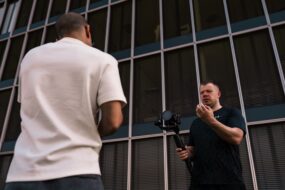
What Is Visual Storytelling
Visual storytelling is all about using visual elements to tell a story or convey a message. It’s about communicating through images, colors, and compositions to evoke emotions and connect with an audience on a deeper level. By tapping into our natural affinity for stories and our ability to quickly process visual information, visual storytelling becomes a powerful communication tool.
Visual storytelling combines various elements to craft engaging and memorable narratives. Here are some key elements involved:
-
Images: Powerful visuals that capture attention and convey the essence of the story at a glance.
-
Colors: Use color palettes to set the mood and tone, influencing how the audience feels as they experience the narrative.
-
Compositions: Arrange visual elements in a way that guides the viewer’s eye and enhances the storytelling flow.
-
Symbols: Incorporate symbolic imagery to add layers of meaning and engage the audience on multiple levels.
-
Movement: Utilize animation or motion to bring stories to life, adding dynamism and engagement.
These components work together to create a narrative that resonates with audiences, making visual storytelling a go-to strategy for effective communication. Whether through video, photography, or digital design, visual storytelling harnesses the power of visuals to connect and communicate.
Importance of Visual Storytelling
Visual storytelling grabs attention by speaking directly to our emotions. It’s a powerful way to connect, using images and colors to tell stories that stick. By making complex ideas easier to understand, it helps audiences engage more deeply.
Visual storytelling is key in modern communication. It cuts through the noise, making messages clear and memorable. It’s not just about pretty pictures; it’s about crafting a narrative that resonates. This technique is crucial for marketers who want to make a lasting impact. For those interested in how storytelling can create emotional connections and foster brand loyalty, exploring how to make an emotional connection through storytelling can provide valuable insights.
Here are some benefits of visual storytelling:
-
Emotional Connection: Images evoke feelings that words alone can’t match, creating a strong bond with the audience.
-
Accessibility: Simplifies complex information, making it easy to grasp at a glance.
-
Memorability: Engaging visuals help audiences remember the message long after they’ve seen it.
-
Engagement: Visuals draw people in, encouraging them to interact and share.
-
Versatility: Works across different platforms and formats, from social media to presentations.
Incorporating visual storytelling into your strategy can transform how you communicate. It’s about creating a narrative that people want to be part of, driving engagement and making your message unforgettable. For a deeper dive into how concise narrative strategies can enhance your marketing efforts, consider learning about the power of micro-storytelling in marketing campaigns.
Techniques for Effective Visual Storytelling
Visual storytelling relies on a set of techniques that enhance how stories are told through images and motion. Understanding these can elevate your narrative and create a deeper connection with your audience.
Start with Shot Planning. This involves deciding on the sequence and timing of visuals before shooting begins. Effective planning means knowing what you want to convey and selecting visuals that align with the story’s message. It sets the stage for everything that follows.
Camera Angles are crucial. Different angles can change how a scene is perceived. A low angle might make a subject look powerful, while a high angle can create a sense of vulnerability. Choosing the right angle helps in reinforcing the narrative’s emotional tone.
Lighting is another powerful tool. It can set the mood and highlight key elements of a scene. Soft lighting might create an intimate feel, while harsh lighting can add tension or drama. The way light interacts with your subjects can dramatically affect the viewer’s emotional response.
Consider using Visual Metaphors. These are images that symbolize a deeper meaning, adding layers to the story. They can communicate complex ideas quickly and effectively, making your story resonate on multiple levels. For more on crafting compelling stories, explore different storytelling frameworks that can enhance your brand narrative.
Incorporate Sound Design to complement the visuals. Sounds can enhance the atmosphere and evoke emotions. Background music, sound effects, and even silence can significantly impact how a story is received.
Here’s a quick recap of these techniques:
- Shot Planning: Map out your visuals to align with your narrative.
- Camera Angles: Use angles to convey power, vulnerability, and emotion.
- Lighting: Set the mood and highlight important elements.
- Visual Metaphors: Add depth with symbolic imagery.
- Sound Design: Use audio to enhance emotion and atmosphere.
Mastering these techniques can transform your visual storytelling, making it more engaging and memorable.
Role of Visual Elements in Storytelling
Visual storytelling relies on key elements like color, composition, and characters to evoke emotions and guide the viewer’s experience. Each plays a unique role in shaping narratives.
Color is a powerful tool. It sets the mood and influences emotions immediately. Warm colors like red and orange can evoke feelings of passion or urgency, while cool colors like blue and green often suggest calm or tranquility. Using contrasting colors can create tension or highlight important aspects of the story.
Composition directs the viewer’s eye. It’s the arrangement of elements within a frame that guides how the story unfolds visually. A balanced composition can create harmony, while an off-center composition might suggest unease or focus attention on a specific point. Leading lines, symmetry, and framing are techniques that enhance storytelling by controlling what the viewer sees first.
Characters are central to storytelling. They are the vessels through which emotions and narratives are expressed. The way characters are portrayed, their expressions, and their interactions with the environment all contribute to the depth of the story. Strong character design can make the audience connect and empathize with the story on a personal level.
For those looking to dive deeper into how narratives are crafted, exploring storytelling frameworks that enhance brand narratives can provide structured approaches to storytelling. These frameworks, such as the Hero’s Journey and the Three-Act Structure, offer valuable insights into creating compelling stories that resonate with audiences.
Here’s how these elements work in practice:
- Color Usage: Use warm tones for energetic scenes and cool tones for serene moments.
- Composition Techniques: Apply leading lines to draw attention to the focal point.
- Character Focus: Design characters with distinct features that convey their personality and role.
These elements combined can transform a simple story into a compelling visual narrative that resonates deeply with audiences.
Shot Sizes and Angles
Shot sizes and angles shape how stories unfold visually. They guide the viewer’s eye, set the scene, and highlight important elements, impacting how the audience connects with the story emotionally.
Choosing the right shot size can emphasize details or provide context. A close-up reveals emotions, a medium shot captures interactions, and a wide shot sets the scene. Each shot size has its purpose, enhancing storytelling by focusing on what matters most.
Angles add another layer to storytelling. They influence how a subject is perceived. A low angle can make a character seem powerful, while a high angle might suggest vulnerability. These choices contribute to the narrative’s emotional tone. For those looking to delve deeper into how visual elements enhance narratives, exploring techniques in storytelling frameworks for enhancing brand narratives can provide valuable insights.
Here’s a quick list of common shot types and their uses:
- Close-Up: Focuses on a subject’s expression, conveying emotions and details.
- Medium Shot: Shows the subject in context, often used for dialogues and interactions.
- Wide Shot: Captures the full scene, providing context and setting.
- Low Angle: Makes subjects appear strong or intimidating.
- High Angle: Suggests vulnerability or diminishes the subject.
Understanding shot sizes and angles elevates visual storytelling, making narratives more engaging and emotionally resonant. These techniques guide the viewer’s experience, enhancing the story’s impact. For those interested in how these visual techniques can be applied in marketing, our detailed discussion on producing explainer videos offers practical guidance on aligning video content with brand identity.
Camera Movements in Storytelling
Camera movements are key players in storytelling, adding depth and dimension to narratives. They help guide the audience’s attention, reveal new information, and evoke emotions, making the story more immersive and engaging.
Panning is a technique where the camera moves horizontally from one side to another. It’s great for showing a wide expanse of a scene, helping to set the stage or introduce multiple elements gradually. This movement can also follow characters or objects, maintaining focus while transitioning between scenes.
Tracking involves moving the camera alongside a subject, often on tracks or a dolly. It keeps pace with the action, creating a sense of movement and energy. This technique is perfect for chase scenes or when following a character through a dynamic environment.
Crane shots elevate the camera above the scene, offering a bird’s-eye view. This can introduce or conclude a scene, providing a dramatic overview that captures the surroundings’ scale and context. It can also transition between scenes smoothly, adding to the narrative flow.
For those interested in enhancing their video production skills, understanding how to effectively incorporate AI tools can be transformative. Our guide on using AI tools for video editing provides insights into automating repetitive tasks and focusing on storytelling and creative aspects.
Here’s how each movement serves storytelling:
- Panning: Introduces or reveals elements within a wide scene.
- Tracking: Follows action closely, maintaining engagement and continuity.
- Crane Shots: Offers a grand perspective, setting the scene or wrapping up a narrative.
Mastering these movements can elevate your visual storytelling, making it more compelling and dynamic.
Historical Evolution of Visual Storytelling
Visual storytelling has been around for ages. It started with ancient cave paintings, where early humans used images to communicate and tell stories. These paintings were the first attempts at sharing experiences and preserving histories.
As time went on, new forms emerged. Hieroglyphics in Egypt used symbols to tell complex stories. These visuals were crucial in preserving culture and history.
The invention of photography in the 19th century was a major leap forward. It allowed stories to be told with a new level of realism. Pictures captured moments in ways words couldn’t, giving life to stories.
Film revolutionized storytelling in the early 20th century. It combined images with motion, creating dynamic narratives that captivated audiences. Movies became a powerful way to share stories, blending visuals with sound and emotion.
In recent decades, digital media has transformed visual storytelling again. Social media platforms and digital tools have made storytelling more interactive and accessible. These advancements allow for creative expression and audience engagement like never before. For those looking to create impactful visual content, especially in the realm of social media, understanding how to craft compelling narratives that resonate emotionally is crucial. Our guide on creating viral video content for social media provides insights into optimizing content for shareability and engaging with audiences effectively.
Here’s a quick timeline of major advancements:
- Cave Paintings: Early humans used images to communicate.
- Hieroglyphics: Egyptians used symbols for storytelling and record-keeping.
- Photography: Introduced realism to visual narratives.
- Film: Combined motion and sound for dynamic storytelling.
- Digital Media: Expanded storytelling through interactive and social platforms.
These milestones have shaped visual storytelling, making it an essential tool for communication and engagement.
Visual Storytelling Across Different Mediums
Visual storytelling is everywhere. Each medium has its own unique way of engaging audiences, whether it’s in marketing, education, or entertainment. Let’s look at how different mediums use visual storytelling to make a connection.
In marketing, visuals play a key role in grabbing attention and conveying brand messages quickly. Photos, videos, and infographics are tools that marketers use to tell compelling stories. They help simplify complex ideas and make them more relatable. For marketers looking to harness the power of video, Digilenzy provides insights on producing explainer videos and creating viral video content, which are essential for effective storytelling.
Education uses visual storytelling to enhance learning. Diagrams, animations, and videos make information more accessible. They turn abstract concepts into tangible understanding, helping learners retain information better.
Entertainment thrives on visual storytelling. Films, TV shows, and video games immerse audiences in narrative worlds. They use visuals to evoke emotions and drive the story forward, making experiences more engaging and memorable.
Here’s a quick list of mediums where visual storytelling shines:
- Photography: Captures moments and emotions, telling stories through a single frame.
- Film and TV: Combines visuals and sound to create immersive narratives.
- Comics and Graphic Novels: Uses illustrations and text to build complex worlds and characters.
- Animation: Brings stories to life with motion, appealing to all ages.
- Video Games: Offers interactive experiences where players become part of the story.
- Social Media: Engages users with bite-sized, impactful visuals for quick consumption.
Each medium brings its own flair to visual storytelling, connecting with audiences in diverse and effective ways.
Emerging Trends in Visual Storytelling
Virtual reality and interactive media are changing how we tell stories. They’re bringing fresh ways to engage audiences and make things more immersive. These innovations let viewers step into the narrative, offering experiences that feel personal and dynamic.
Virtual reality allows users to experience stories in a fully immersive environment. It lets them explore and interact with the setting, creating a sense of presence that traditional media can’t match. This makes storytelling more engaging and memorable.
Interactive media, on the other hand, invites the audience to participate in the narrative. It can be as simple as choosing the story’s direction or as complex as solving puzzles to advance the plot. This involvement keeps the audience invested and makes each experience unique.
Here’s a list of emerging trends that are reshaping visual storytelling:
- Virtual Reality Experiences: Provide a 360-degree view of narratives, offering a fully immersive experience.
- Interactive Storytelling Platforms: Allow users to influence the storyline, making them active participants.
- Augmented Reality: Blends digital elements with the real world, creating a hybrid storytelling medium. This is part of the broader digital transformation that is impacting marketing strategies, as discussed in our article on what digital transformation means for marketers in 2025.
- Live Streaming: Engages audiences in real-time, offering a direct connection to the narrative.
- User-Generated Content: Encourages audiences to contribute to the story, fostering community engagement.
These trends are not just novelties; they’re redefining how stories are told and experienced. As technology evolves, visual storytelling will keep pushing boundaries, offering new ways to connect and communicate.
Practical Tips for Effective Visual Storytelling
Knowing your audience is key in visual storytelling. Understand who you’re speaking to and what resonates with them. This knowledge allows you to tailor your visuals to evoke the right emotions and connect deeply. For more insights on creating content that truly engages your audience, explore our tips for writing long-form content that keeps readers engaged.
Consistency is crucial. Keep your visual style uniform across all your content. This builds recognition and strengthens your brand’s identity. Whether it’s color schemes, fonts, or imagery style, consistency helps maintain a cohesive story.
Use high-quality visuals. They grab attention and convey professionalism. Blurry or pixelated images can distract and diminish your message. Invest in good equipment or hire professionals to ensure your visuals are top-notch.
Remember to focus on the narrative. Every visual should serve the story. Avoid unnecessary elements that clutter the message. Each piece should contribute to the overall narrative, guiding the audience through your story seamlessly.
Pay attention to color and composition. Colors set the mood, and composition guides the viewer’s eye. Use these elements strategically to emphasize key parts of your story and maintain viewer engagement. To ensure your visual elements align with your brand, consider our step-by-step guide to designing a brand logo that lasts, which offers valuable insights into creating a cohesive visual identity.
Here’s a quick checklist for effective visual storytelling:
- Know Your Audience: Tailor visuals to resonate with them.
- Maintain Consistency: Use uniform visual styles for brand recognition.
- Use High-Quality Visuals: Ensure professionalism and clarity.
- Focus on the Narrative: Keep visuals relevant to the story.
- Strategic Use of Color and Composition: Set mood and guide focus.
These tips can help elevate your visual storytelling, making your narratives more engaging and memorable.
Benefits for Marketers and Brands
Visual storytelling transforms how brands connect with audiences. It grabs attention and builds brand identity. Images and visuals create memorable stories that stick. Through visuals, brands forge emotional bonds with their audience.
Visual storytelling enhances marketing communication. It breaks down complex ideas into digestible pieces. When audiences connect with visual content, they engage more and share it with others. To further understand how a consistent brand voice can enhance these connections, consider exploring strategies for maintaining a cohesive brand voice across all platforms, which can help in creating a seamless brand experience.
Here are some specific advantages:
-
Brand Recognition: Visual narratives create a distinct brand image that people remember.
-
Emotional Resonance: Images spark emotions that text alone cannot reach, building genuine loyalty.
-
Simplified Messaging: Visuals make complex concepts clear, helping people understand and remember.
-
Increased Engagement: Visual content draws people in, leading to more shares and interactions.
-
Cross-Platform Versatility: Visual stories work everywhere – social media, websites, and traditional ads.
Visual storytelling connects you with your audience in meaningful ways. It amplifies your message and creates lasting relationships with customers.
Key Takeaways From Visual Storytelling
Visual storytelling is all about making connections. It uses powerful images, colors, and compositions to communicate effectively. It’s about crafting narratives that resonate and engage.
Mastering this art means understanding how various elements work together. Think about your audience and what messages will speak to them. A well-told visual story is memorable and impactful.
Here are some actionable takeaways to refine your approach:
- Know Your Audience: Tailor your visuals to resonate with their interests and emotions.
- Use High-Quality Imagery: Ensure your visuals are clear and professional, enhancing your credibility.
- Maintain Consistency: Keep a uniform style across your visuals to strengthen brand identity.
- Focus on the Narrative: Every element should contribute to your story, keeping it clear and engaging.
- Leverage Color and Composition: Use these tools strategically to set the mood and guide the viewer’s focus.
- Incorporate Visual Metaphors: Add depth and convey complex ideas quickly.
- Experiment with Different Mediums: Try photography, video, or animation to see what best suits your story.
Refining these techniques helps you communicate more effectively, creating stories that stick. It’s about connecting with your audience on a deeper level, leaving a lasting impression.











No Comments